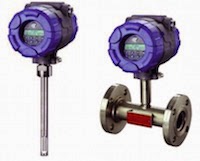 |
Thermal dispersion level and flow
instruments (courtesy of Magnetrol) |
Thermal dispersion instruments work on the basis of heat transfer. The sensing probe consists of two separate components, both RTDs (temperature detectors). One RTD is used as the reference point and measures the temperature of the fluid right where the probe is immersed. The second RTD is self-heated to a known temperature and maintained. A resulting a temperature differential is created between the two RTDs. By varying the power to the self-heated RTD, the set point can be changed which allows the user to set the instrument for a specific application.
Convective heat is the mechanism of heat transfer for thermal technology
level switches based on the principle that a liquid has a thermal conductivity far greater than the thermal conductivity of its corresponding vapor. When the sensor is dry, there is a temperature difference between the two sensors. When fluid comes in contact with both RTDs, there is a cooling effect as the liquid absorbs the heat from the self-heater RTD. The resulting temperature differential drops, and creates a point for high level reference. When the level drops and the sensor goes dry, the temperature difference increases again. The instrument electronics senses the increase in temperature difference and provides a low level reference.
When used for
flow applications, the temperature difference under a low flow or no flow condition is controlled by the set point. As the flow rate increases, the sensing RTD is cooled by the fluid moving past the heated sensor - the greater the flow, the greater the cooling. Conversely, the reduction in the temperature differential between the two RTDs indicates that the flow rate is exceeding the set point of the instrument.
